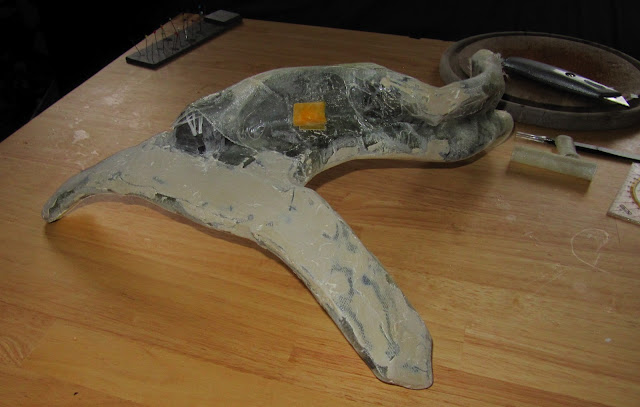outline
The mounting platform's foam core was build from XPS leftovers from building the model head. We didn't use fancy CAD to design this part but fitted it directly onto the model.
The process split up into three phases:
Forehead-part, supplying forward stability
- Aft section, trying to use the hairs as a support, sideway stability
Middle section, merges the two, location of the horn
This decision was more work in progress based, than careful planning. Smaller workloads were easier to handle and especially easier to remove from the mold.
forehead
We cut out and clued together small pieces of XPS, approximately 4 cm wide and build two layers adding up to approx. 1cm hight. Tight fit was a concern, but one hat to plan with the added millimeters the laminat would take.
A base layer of 300g/cm^2 beneath and on to of the core, a layer of lighter fabric covering it and the 3cm wide tape along the edges. We used needles to pull the fine-meshed tape over the foam-core edge to ensure a nice edge. Otherwise the tape wouldn't have followed the topology. Again the black tape from the core is well visible beneath the now transparent laminate.
We went the standard releasing agent way that would have ensured a clean separation from the mould, but that didn't work to our satisfaction. And we partly ripped of the filler from the model, as can be seen in later picture.
aft section
For a more precise fit, we got back to the paper patterns used to cut the slices for the head and build 'negatives' for the region of interest along the hair.
Those slices were stacked, just as we did with the model head. But for optimized fit to the model, we smoothed the surface by cutting away the staircases.
As the releasing agent didn't work out for us, cling wrap was the weapon of choice. We added thin foam material between the model and the wrap to more evenly convey force from the model to the XPS-foam core. This way the laminate would lie flat on the core and leave some room between model and the structure after removing the foam material.
To press the core against the model we turned the window bench into a workbench. Outfitting it with sticks exerting pressure on the foam core. This was a work in progress operation, we hadn't planned out the details, we had not tried this before. This explains the electro tape to join the bolts. It worked for us.
The structure follows the hair in a big 'C' shape, but at the base of the hair the edge is almost straight, creating quite some overlap, that could help keep the platform in place.
And again from a different angle. As you can see, on the side facing away from the hair the fabric is sticking out. Bur our main interest here was to get the hair-facing side right.
In a last step we cut all laminate on the outside, that hung over the edges or didn't follow the cores geometry. See next picture.
middle section
The junction was prepared from XPS agin. Technique used was roughly cutting out parts of the estimated size, glue them together and afterwards shape in place with a sharp knife. We were a little tired of precision cutting a lot of pieces, as we had done with the aft section, so the slices are arranged along the axis.
This was the result: New foam core in the middle section and cut laminate-edges on the side of the aft section facing towards us.
Lamination was quite simple 2 base layers 300g/cm^2 covered with the lighter, finer fabric to allow better control of the resulting surface.
We also covered the outside of the aft-section where the foam core was still visible. Nothing fancy there. For increased and more even pressure, we added water bags, in the hope of getting a clean finish on surfaces not facing the mould.

This is the result after a quick filling and sanding run. To strap the platform to the head, we outfitted it with a hole for the rubber band to go through. For additional stability in this area, the walls of the hole are strengthened by outfitting it with a glass-reinforced tube we had laminated before. The yellow tape covers this tube, as it's glued in.
And finally in the context of the model Head. If one paced the aft at the base of the ear and then carefully slided the front-part over forehead, no force was needed. The platform fitted very well and the only direction of free movement was away from the hair, towards the viewer. All other directions were prohibited.
Sorry for the lengthy post, but we think that this was the key moment in the whole process. Without the mounting platform there wouldn't be a unicorn at our university.











































